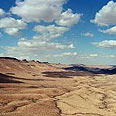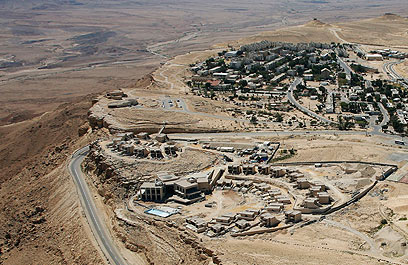
Visit to Makhtesh Ramon desert crater
Karen Schwartz tries to get 10-year-old interested in Israel's natural geography book, telling stories that in some instances date back 220 million years
I hoped the lure of looking for a living Eeyore would be enough to get my 10-year-old interested as we stood looking out over Makhtesh Ramon in Israel's Negev Desert, one of the world's largest erosion craters.
I understood her disinterest. As far as we could see, there was only rock and sand. But the makhtesh is a natural geography book, telling stories that in some instances date back 220 million years, and I didn't want to miss the opportunity to explore.
It was only 9 am and already it was hot. The visitors' center was closed for renovations, and if we hadn't needed to refill our water bottles, we might have bypassed the unimpressive looking Bio-Ramon.
Once we'd paid the $3.75 entry fee into the small menagerie, we headed for the shade and watched a short English film about the erosion process that carved the makhtesh. It's 24 miles in length, 6 miles wide, and a third of a mile down.
A naturalist then offered us a tour, showing us the resident porcupines, lizards, scorpions and turtles. When she pulled out a diadem snake and handed it to my daughter, I saw the first smile of the day.
With lots of water and a map issued by the Israel Nature and Parks Authority, we blasted the car's air conditioning and wound our way down into the crater. Our first stop was a rock formation called the Carpentry Shop, where a wooden sidewalk let us walk above the rare geometric sandstone crystals that jut from the ground in regimented rows.
Next, following a recommendation from the naturalist, we stopped at a site not on the map. Mounds of pink, orange, yellow, purple and brown sand had been left in a small valley. Just off the parking lot, a park worker sat in the shade of an awning, handing test tubes to visitors who wanted to take home a souvenir. Looking around, I noticed nearby cliffs with strata of vividly colored sand, and while I marveled at nature's sand art, my daughter was busy creating hers. (Later, I would learn that layers of sediment from the Triassic, Jurassic and Cretaceous periods are exposed in the makhtesh.)
Although we had traveled less than five miles, we had done so leisurely and the morning had passed. The naturalist had told us there was only one place for food in the crater, a "snack bar" at the Be'erot campground. As we bumped along the rutted dirt access road, we were surprised by five modern tour buses approaching from out of the shimmering heat. We were even more surprised a few minutes later when we pulled into the campground, and the "snack bar" was a Bedouin tent.
In a mix of languages and gestures, we ordered lunch and were invited to sit on striped mats around a low table with a fuchsia tablecloth. Although it was peak tourist season and the adjacent campground appeared full, we were the only ones dining in the enormous tent, glad to have missed the tour groups.
Country's largest nature reserve
Our food was typical Middle Eastern fare, but served in Styrofoam bowls. There was pita, hummus, tahini, olives, yogurt, pickled vegetables, and salads of eggplant, tomato and cucumber, and lettuce. The young waiter brought us sweet mint tea and coffee from an open fire at one end of the tent where six large pots boiled.
After paying about $7 per person for the food and hospitality, we had only a few hours to complete our search for the elusive onager. Hunted to extinction in Israel and neighboring Syria in 1927, they were reintroduced to Makhtesh Ramon in the 1980s, and now number more than 100. Knowing that they often frequent the crater's only water source, Ein Saharonim, we knew our next destination.
Of course water is crucial to more than desert wildlife, and the trip to the river also took us to the remains of a stop on the ancient Nabatean Incense Route. Camel caravans that transported frankincense and myrrh from the Arabian Peninsula to the Mediterranean used the Saharonim Stronghold as one of their resting places. The trade route, used from the 3rd century B.C. to the 2nd century A.D., is now a UN World Heritage Site.
There was little water in the riverbed, which sometimes dries completely in the summer, and no onagers. Still, the scenery was spectacular with cliffs and caves and the only greenery we'd seen in the crater.
My daughter was disappointed, but there was still one type of animal — or former animal — I knew she could see for sure. We drove deeper into the makhtesh, then walked for about 15 minutes until we reached the Ammonite Wall. Here, hundreds of fossilized marine animals were visible on the slope. The naturalist had warned us that souvenir hunters had removed the best of it, but it was still fascinating.
Heading back up the two-lane highway to the sleepy town of Mitzpeh Ramon, we finally did spot some wild animals, standing just off the road. Perhaps it was fitting that our encounter was with ibex, the wild goat whose image is the logo for the Parks Authority. Makhtesh Ramon is Israel's largest nature reserve.
Returning to our hotel, we ended our adventure without seeing an onager. Still, my daughter said it had been an "awesome" day — and coming from a tired 10-year-old, that was enough to make a mother — and maybe even Eeyore — smile.
- Follow Ynetnews on Facebook











